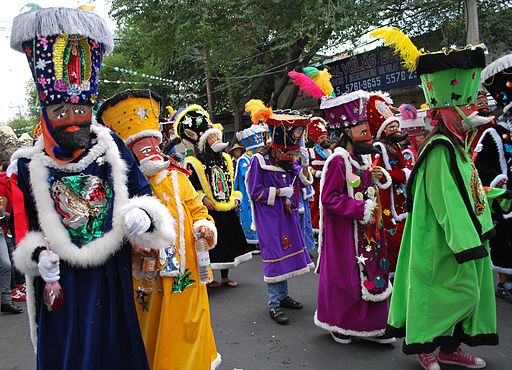Tlayacapan, Morelos, is one of Mexico’s “Pueblos Mágicos” or Magic Villages, a distinction awarded by the Mexican Ministry of Tourism to locations in Mexico that meet special cultural, natural, and historical criteria.
Located in the hills beyond Tepoztlán in the state of Morelos, Mexico,the village of Tlayacapan is known for its clay and ceramic pottery and figurines, both plain and colorfully glazed. Typical food of the area includes red mole with turkey, cecina (thinly sliced, salted meat), and green mole made with squash seeds.
El Convento de San Juan Bautista
In 1534 the Augustinian order, under Jorge de Avila and Father Melgarejo, began the construction of Tlayacapan’s first church, later converted into a convent. The Convent of St. John the Baptist features several murals as well as an ancient rainwater collection system which is still in operation today. The convent was declared a World Heritage site by UNESCO in 1996.
The local village museum, housed in what used to be the Refectory of the convent, exhibits various archaeological pieces, frescoes, and mummified bodies which were discovered in the nave during recent restoration work in the Convent.
Centro Cultural La Cerería
The “La Cerería” (Waxworks) Cultural Center is housed In a restored 17th C. candle factory. The center periodically features exhibitions of photography, arts and crafts of this and other regions. Visit the Cerería Facebook page for more information.
Los Chinelos
It is reported that in the 1800s, some of the local natives of Tlayacapan got together whatever came to hand as noisemakers, gathered old clothing and rags to fashion costumes, and began dancing through the streets, mocking the dress and demeanor of the well-to-do Spanish and French colonialists during their frequent religious festivals from which the Indians were often excluded . The spontaneous amusement was looked on favorably by both the town’s youngsters and older people, and the lively dance or “brinco” took hold in subsequent years, turning into what is now known as the Dance of the Chinelos.
The Chinelo dance is performed during Carnival (prior to Ash Wednesday) in both Tlayacapan and Tepoztlán and at the Tepozteco Festival on September 7 and 8.
The Chinelos, dressed in colorful attire with bearded masks and elaborately decorated headgear, dance (or rather bounce) through the town accompanied by drums and other instruments and followed by fellow revelers and townspeople.

The word “chinelos” is derived from the Nahuatl word “zineloquie” which means “disguised.” The dance is one of many to develop after the Spanish conquest as native traditions and rites blended into Christian festivals. One of these is Carnival, with its traditions of wearing masks, role reversal, anonymity and behaviors not normally tolerated. This dance developed as a mockery of the Europeans with their fine clothing, beards, fair skin and mannerisms […] in the state of Morelos, part of the State of Mexico, part of the Federal District of Mexico City (generally in the south) and even as far as the municipality of Taxco in Guerrero .
[ … ]
As the tradition spread and developed, especially in Morelos, other towns and groups made distinctive changes to their Cýhinelos gear, and today each town and troupe has its own distinctive elements. This began the process of making extremely elaborate costumes in some places. In Yautepec, the best costumes are made of velvet and are entirely covered in designs and images made from beads, sequins, ribbing and imitation precious stones. These decorative elements can be expensive such as quality beads imported from the Czech Republic . The hats have pre-Hispanic images and modern interpretations of ancient legends. In Tepotzlán, the tunic is made from black velvet and is completely smooth with the image on the back painted on, rather than stitched. The feather decoration in the hat is made of fabric. The hat became higher, straighter and more elaborate, with a black velvet tunic embroidered with sequins.
The Chinelos’ masks are made of mesh and always feature an upturned beard and European features. It and the bandana wrapped around the head are essential in keeping Chinelos’ identities secret, something reinforced with the use of gloves on the hands. To further assure anonymity, costumes are closely guarded and kept secret. Members of the troupe dress in different houses to add to the confusion.
Wikipedia contributors, “Chinelos,” Wikipedia, The Free Encyclopedia, http://en.wikipedia.org/w/index.php?title=Chinelos&oldid=603943040 (accessed May 25, 2014).
Chinelos at Carnival in Tepoztlan, near Tlayacapan, Morelos
Sources and Resources
- Tlayacapan, Pueblo Mágico de Morelos, MorelosTuristico.com, http://www.morelosturistico.com/espanol/pagina/z_520_Tlayacapan_Pueblo_Magico_de_Morelos..php
- http://chineloslaura.wordpress.com/history/
- http://loschinelos.blogspot.com/
- http://www.visitmexico.com/es/pueblosmagicos/region-centro/tlayacapan
- Photo credit: ChinelosSanJuanDoctores201101.jpg. By AlejandroLinaresGarcia (Own work) [CC-BY-SA-3.0 (http://creativecommons.org/licenses/by-sa/3.0)], via Wikimedia Commons